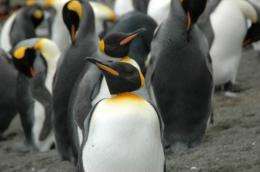Penguin colony flourishing after being driven to brink of extinction

Eighty years after slipping to the brink of extinction, a colony of King Penguins at Macquarie Island in the Southern Ocean has rebounded and is flourishing through conservation efforts, Australian researchers have found.
Using ancient DNA methodology, a team from Griffith University’s Environmental Futures Centre compared samples from the current population with shavings taken from sub-fossil bones to show that the modern-day birds have recovered the genetic diversity of their forebears.
Two very large colonies were present when Macquarie Island was discovered in 1810, one at the Isthmus and one at Lusitania Bay.
But the first settlers “sought to harvest blubber oil, among other products, initially from Fur Seals followed by Elephant Seals, King Penguins and finally Royal Penguins”, the researchers reported in the journal Biology Letters.
As a result, the King Penguin colony at the Isthmus on Macquarie Island was wiped out by 1894 and the colony at Lusitania Bay was reduced to about 3400 birds by 1930.
The oil blubber industry devastated not only the Macquarie Island populations of the species but also populations on other islands, most of which are now on the rise again, said lead researcher and PhD candidate Tim Heupink, who worked in collaboration with John van den Hoff from the Australian Antarctic Division.
There are now up to 500,000 King Penguins across the island.
Macquarie Island was declared a wildlife sanctuary in 1933, a state reserve in 1972 and a World Heritage area in 1997. The protection allowed the population to flourish again.
“The research shows that King Penguins on Macquarie Island were remarkably quick at recovering genetic diversity lost in the past. In just 80 years they reached the genetic diversity measured in a reference population from 1,000 years ago,” said Mr Heupink.
“It also shows that by comparing ancient and modern DNA we can monitor the success of conservation efforts (and other human impacts). In this case, putting an end to exploiting King Penguins and controlling fishing and pests have clearly helped them to recover so quickly.”
This method, of comparing ancient and modern DNA, can be used on any species that leaves behind bones and in which the DNA is relatively well preserved, he said. “It’s already been used for other species, but this study is one of the few where a recovery of genetic diversity is actually seen.”
Provided by The Conversation
This story is published courtesy of the The Conversation (under Creative Commons-Attribution/No derivatives).

















